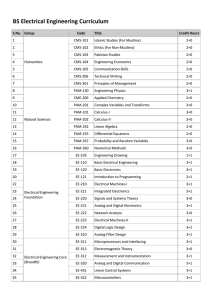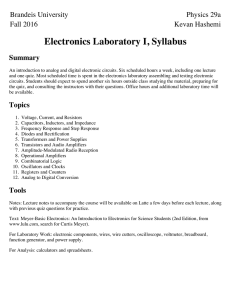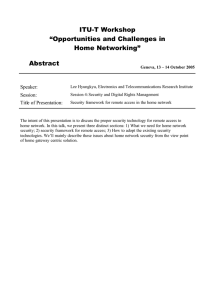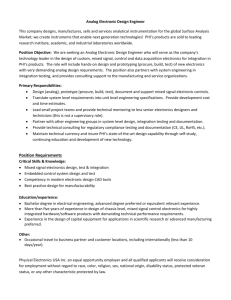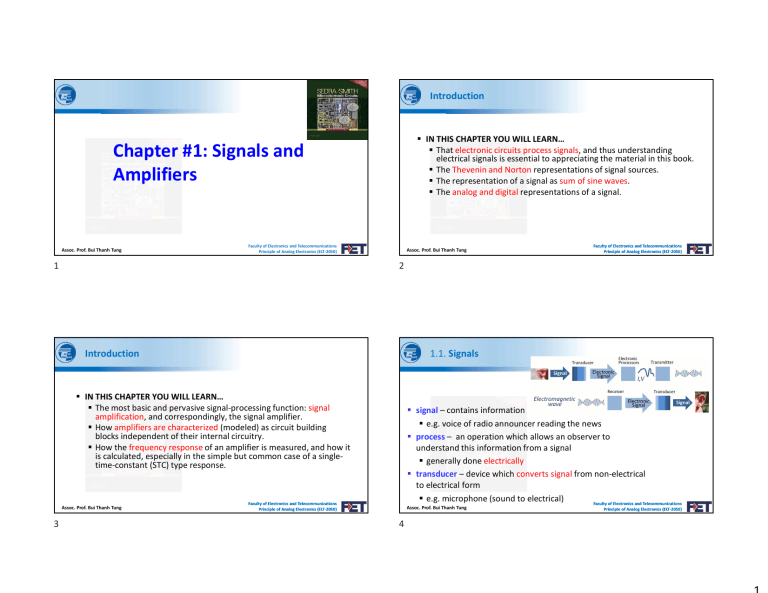
Introduction IN THIS CHAPTER YOU WILL LEARN… That electronic circuits process signals, and thus understanding electrical signals is essential to appreciating the material in this book. The Thevenin and Norton representations of signal sources. The representation of a signal as sum of sine waves. The analog and digital representations of a signal. Chapter #1: Signals and Amplifiers Assoc. Prof. Bui Thanh Tung Faculty of Electronics and Telecommunications Principle of Analog Electronics (ELT-2050) 1 Assoc. Prof. Bui Thanh Tung 2 Introduction 1.1. Signals IN THIS CHAPTER YOU WILL LEARN… The most basic and pervasive signal-processing function: signal amplification, and correspondingly, the signal amplifier. How amplifiers are characterized (modeled) as circuit building blocks independent of their internal circuitry. How the frequency response of an amplifier is measured, and how it is calculated, especially in the simple but common case of a singletime-constant (STC) type response. Assoc. Prof. Bui Thanh Tung 3 Faculty of Electronics and Telecommunications Principle of Analog Electronics (ELT-2050) signal – contains information e.g. voice of radio announcer reading the news process – an operation which allows an observer to understand this information from a signal generally done electrically transducer – device which converts signal from non-electrical to electrical form e.g. microphone (sound to electrical) Faculty of Electronics and Telecommunications Faculty of Electronics and Telecommunications Principle of Analog Electronics (ELT-2050) Assoc. Prof. Bui Thanh Tung 4 Principle of Analog Electronics (ELT-2050) 1.1: Signals Example 1.1: Thevenin and Norton Equivalent Sources Q: How are signals represented? A: thevenin form – voltage source vs(t) with series resistance RS preferable when RS is low A: norton form – current source is(t) with parallel resistance RS preferable when RS is high Consider two source / load combinations to upper-right. note that output resistance of a source limits its ability to deliver a signal at full strength Q(a): what is the relationship between the source and output when maximum power is delivered? for example, vs < vo??? vs > vo??? vs = vo??? Q(b): what are ideal values of RS for norton and thevenin representations? Figure 1.1: Two alternative representations of a signal source: (a) the Thévenin form; (b) the Norton form. Assoc. Prof. Bui Thanh Tung Faculty of Electronics and Telecommunications Principle of Analog Electronics (ELT-2050) 5 6 1.2. Frequency Spectrum of Signals What is a Fourier Series? frequency spectrum – defines the a time-domain signal in terms of the strength of harmonic components Q: What is a Fourier Series? A: An expression of a periodic function as the sum of an infinite number of sinusoids whose frequencies are harmonically related Assoc. Prof. Bui Thanh Tung 7 Faculty of Electronics and Telecommunications Principle of Analog Electronics (ELT-2050) Assoc. Prof. Bui Thanh Tung decomposition – of a periodic function into the (possibly infinite) sum of simpler oscillating functions Fourier Series Representation of f (x ) a0 f(x) ak cos(kx) bk sin(kx) 2 k 1 1 ak f( x)cos(kx)dx , n0 bk Faculty of Electronics and Telecommunications Principle of Analog Electronics (ELT-2050) Assoc. Prof. Bui Thanh Tung 8 1 f( x)sin(kx)dx , n1 Faculty of Electronics and Telecommunications Principle of Analog Electronics (ELT-2050) What is a Fourier Series? (2) Fourier Series Example step #1: define ak for the square wave note that the piece-wise square wave must be divided in two dc functions Q: How does one calculate Fourier Series of square wave below? A: See upcoming slides… 0 Va Va ak cos(kx)dx cos(kx)dx 0 0 0 Faculty of Electronics and Telecommunications Principle of Analog Electronics (ELT-2050) Assoc. Prof. Bui Thanh Tung 9 1 sin kx k 1 sin kx k 0 1 1 sin k 0 sin k k k 1 1 sin k sin k 0 k k 00 00 Assoc. Prof. Bui Thanh Tung Faculty of Electronics and Telecommunications Principle of Analog Electronics (ELT-2050) 10 Fourier Series Example Fourier Series Example step #2: define bk for the square wave if k is even 0 Va V bk Va sin(kx)dx a sin(kx)dx 0 0 Assoc. Prof. Bui Thanh Tung 11 1 cos kx k 1 cos kx k 0 1 1 cos k 0 cos k k k 1 1 cos k cos k 0 k k 1 1 (-1)k k k 1 1 (-1)k k k 4Va k is odd bk k k is even 0 step #3: define Fourier Series 4Va 0 0 k a0 f(x ) ak cos(kx) bk sin(kx) 2 k 1 1 sin(k0t ) 4V k is odd f( x ) a k k 1 k is even 0 f( x ) Faculty of Electronics and Telecommunications Principle of Analog Electronics (ELT-2050) x 0t 4Va 1 1 sin(0t ) sin(30t ) sin(50t ) 3 5 Assoc. Prof. Bui Thanh Tung 12 this series may be truncated because the magnitude of each terms decreases with k… Faculty of Electronics and Telecommunications Principle of Analog Electronics (ELT-2050) Fourier Series Example 1.2. Frequency Spectrum of Signals Examine the sinusoidal wave below… v a (t ) Va sin(t ) Va amplitude in volts angular frequency in rad/sec = phase shift in rad t time in sec root mean square magnitude = sine wave amplitude / square root of two Figure 1.6: The frequency spectrum (also known as the line spectrum) of the periodic square wave of Fig. 1.5. Assoc. Prof. Bui Thanh Tung Faculty of Electronics and Telecommunications Principle of Analog Electronics (ELT-2050) 13 Faculty of Electronics and Telecommunications Principle of Analog Electronics (ELT-2050) Assoc. Prof. Bui Thanh Tung 14 1.2. Frequency Spectrum of Signals 1.3. Analog and Digital Signals Q: Can the Fourier Transform be applied to a non-periodic function of time? A: Yes, however (as opposed to a discrete frequency spectrum) it will yield a continuous… analog signal – is continuous with respect to both value and time discrete-time signal – is continuous with respect to value but sampled at discrete points in time digital signal – is quantized (applied to values) as well as sampled at discrete points in time Figure 1.9 Block-diagram representation of the analog-to-digital converter (ADC). Assoc. Prof. Bui Thanh Tung 15 Faculty of Electronics and Telecommunications Principle of Analog Electronics (ELT-2050) Assoc. Prof. Bui Thanh Tung 16 Faculty of Electronics and Telecommunications Principle of Analog Electronics (ELT-2050) 1.3. Analog and Digital Signals 1.3. Analog and Digital Signals analog signal sampling discrete-time signal digital signal quantization Faculty of Electronics and Telecommunications Principle of Analog Electronics (ELT-2050) Assoc. Prof. Bui Thanh Tung 17 Assoc. Prof. Bui Thanh Tung Faculty of Electronics and Telecommunications Principle of Analog Electronics (ELT-2050) 18 1.3. Analog and Digital Signals digital digital and binary 1.4. Amplifiers Q: Are digital and binary synonymous? A: No. The binary number system (base2) is one way to represent digital signals. Q: Why is signal amplification needed? A: Because many transducers yield output at low power levels (mW) linearity – is property of an amplifier which ensures a signal is not “altered” from amplification distortion – is any unintended change in output base 10 base 2 y b0 20 b1 21 b2 22 LSB n 1 b3 23 b n1 2 MSB Assoc. Prof. Bui Thanh Tung 19 Faculty of Electronics and Telecommunications Principle of Analog Electronics (ELT-2050) Assoc. Prof. Bui Thanh Tung 20 Faculty of Electronics and Telecommunications Principle of Analog Electronics (ELT-2050) 1.4.1. Signal Amplification 1.4.2. Amplifier Circuit Symbol voltage amplifier – is used to boost voltage levels for increased resolution. power amplifier – is used to boost current levels for increased “intensity”. output / input relationship for amplifier v o (t ) Av v i (t ) Figure 1.11: (a) Circuit symbol for amplifier. (b) An amplifier with a common terminal (ground) between the input and output ports. voltage gain Faculty of Electronics and Telecommunications Principle of Analog Electronics (ELT-2050) Assoc. Prof. Bui Thanh Tung 21 22 1.4.4. Power and Current Gain 1.4.5. Expressing Gain in Decibels Q: What is one main difference between an amplifier and transformer? …Because both alter voltage levels. A: Amplifier may be used to boost power delivery. power gain ( Ap ) Assoc. Prof. Bui Thanh Tung 23 Faculty of Electronics and Telecommunications Principle of Analog Electronics (ELT-2050) Assoc. Prof. Bui Thanh Tung Q: How may gain be expressed in decibels? voltage gain in decibels 20 log Av dB load power (PL ) vo io input power (PI ) vi ii Faculty of Electronics and Telecommunications Principle of Analog Electronics (ELT-2050) current gain in decibels 20 log Ai dB power gain in decibels 10 log(Ap )dB Assoc. Prof. Bui Thanh Tung 24 Faculty of Electronics and Telecommunications Principle of Analog Electronics (ELT-2050) 1.4.6. Amplifier Power Supply 1.4.6. Amplifier Power Supply conservation of power – dictates that power input (Pi) plus that drawn from supply (Pdc) is equal to output (PL) plus that which is dissipated (Pdis). Pi + Pdc = PL + Pdissapated supplies – an amplifier has two power supplies VCC is positive, current ICC is drawn VEE is negative, current IEE is drawn power draw – from these supplies is defined below Pdc = VCC ICC + VEE IEE efficiency – is the ratio of power output to input. efficiency = PL / (Pi + Pdc) Faculty of Electronics and Telecommunications Principle of Analog Electronics (ELT-2050) Assoc. Prof. Bui Thanh Tung 25 Assoc. Prof. Bui Thanh Tung Figureof 1.13: An amplifier that requires two dc Faculty Electronics and Telecommunications supplies batteries) for operation. Principle(shown of Analogas Electronics (ELT-2050) 26 1.4.7. Amplifier Saturation 1.5. Circuit Models for Amplifiers limited linear range – practically, amplifier operation is linear over a limited input range. saturation – beyond this range, saturation occurs. output remains constant as input varies model – is the description of component’s (e.g. amplifier) terminal behavior neglecting internal operation / transistor design L Lminus vi plus Av Av or... L v L Assoc. Prof. Bui Thanh Tung minus o plus 27 Faculty of Electronics and Telecommunications Principle of Analog Electronics (ELT-2050) Assoc. Prof. Bui Thanh Tung 28 Faculty of Electronics and Telecommunications Principle of Analog Electronics (ELT-2050) 1.5.1. Voltage Amplifiers model of amplifier input terminals Ri input voltage vi (v s ) R R i source s volt. source and input resistances 1.5.1. Voltage Amplifiers model of amplifier output terminals RL output voltage vo (Avovi ) R R L open-ckt o output Q: How can one model the amplifier behavior from previous slide? A: Model which is function of: vs, Avo, Ri, Rs, Ro, RL voltage output and load resistances R RL i RL Avov s Ri vo Avo (v s ) R R R R source R R R i L i s L Ro s o volt. source and output and input load resistances resistances open-ckt output voltage Faculty of Electronics and Telecommunications Principle of Analog Electronics (ELT-2050) Assoc. Prof. Bui Thanh Tung 29 Assoc. Prof. Bui Thanh Tung 30 1.5.1. Voltage Amplifiers 1.5.1. Voltage Amplifiers ideal amplifier model – is function of vs and Avo only!! It is assumed that Ro << RL… It is assumed that Ri << Rs… non-ideal model ideal model Q: What is one “problem” with this behavior? A: Gain (ratio of vo and vs) is not constant, and dependent on input and load resistance. R RL i RL Avov s Ri vo Avo (vs ) source Ri Rs RL Ro Ri Rs RL Ro volt. source and output and input load resistances resistances open-ckt output voltage The ideal amplifier model neglects this Facultynonlinearity. of Electronics and Telecommunications Assoc. Prof. Bui Thanh Tung 31 Faculty of Electronics and Telecommunications Principle of Analog Electronics (ELT-2050) Principle of Analog Electronics (ELT-2050) key characteristics of ideal voltage amplifier model = high input impedance, low output impedance Faculty of Electronics and Telecommunications Assoc. Prof. Bui Thanh Tung 32 Principle of Analog Electronics (ELT-2050) 1.5.1. Voltage Amplifiers 1.5.2. Cascaded Amplifiers In real life, an amplifier is not ideal and will not have infinite input impedance or zero output impedance. Cascading of amplifiers, however, may be used to emphasize desirable characteristics. first amplifier – high Ri, medium Ro last amplifier – medium Ri, low Ro aggregate – high Ri, low Ro ideal amplifier model – is function of vs and Avo only!! It is assumed that Ro << RL… It is assumed that Ri << Rs… Ri RL vo Avov s Avov s Ri Rs RL Ro ideal model non-ideal model key characteristics of ideal voltage amplifier model = source resistance RS and load resistance RL have no effect on gain Assoc. Prof. Bui Thanh Tung Faculty of Electronics and Telecommunications Principle of Analog Electronics (ELT-2050) 33 Faculty of Electronics and Telecommunications Principle of Analog Electronics (ELT-2050) Assoc. Prof. Bui Thanh Tung 34 Example 1.3: Cascaded Amplifier Configurations Example 1.3: Cascaded Amplifier Configurations Examine system of cascaded amplifiers on next slide. Q(a): What is overall voltage gain? Q(b): What is overall current gain? Q(c): What is overall power gain? aggregate amplifier with gain Av vL v s i i Rs Figure 1.17: Three-stage amplifier for Example 1.3. Assoc. Prof. Bui Thanh Tung 35 Faculty of Electronics and Telecommunications Principle of Analog Electronics (ELT-2050) Assoc. Prof. Bui Thanh Tung 36 Faculty of Electronics and Telecommunications Principle of Analog Electronics (ELT-2050) 1.5.3. Other Amplifier Types Voltage amplifier Transconductance amp. 1.5.3. Other Amplifier Types Current amplifier Av 0 37 i0 vi Assoc. Prof. Bui Thanh Tung Av 0 i0 ii with v 0 0 with v0 0 Ri 0 Ro current amplifier transresistance amplifier Ri Ro Rm Ri 0 v0 with R ii Faculty o 0 i 0of Electronics and Telecommunications 0 Principle of Analog Electronics (ELT-2050) 38 1.5.4. Relationship Between Four Amp Models 1.5.5. Determining Ri and Ro interchangeability – although these four types exist, any of the four may be used to model any amplifier they are related through Avo (open circuit gain) current to voltage amplifier transcond. to voltage amplifier Q: How can one calculate input resistance from terminal behavior? A: Observe vi and ii, calculate via Ri = vi / ii Q: How can one calculate output resistance from terminal behavior? A: Remove source voltage (such that vi = ii = 0) Apply voltage to output (vx) Measure negative output current (-io) Calculate via Ro = -vx / io transres. to voltage amplifier Ro R Avo Ais GmRo m Ri Ri Assoc. Prof. Bui Thanh Tung 39 i0 0 Ri Ro 0 transconductance amplifier Gm Faculty of Electronics and Telecommunications Principle of Analog Electronics (ELT-2050) with voltage amplifier Transresistance amp. Assoc. Prof. Bui Thanh Tung v0 vi Faculty of Electronics and Telecommunications Principle of Analog Electronics (ELT-2050) Assoc. Prof. Bui Thanh Tung 40 Faculty of Electronics and Telecommunications Principle of Analog Electronics (ELT-2050) Section 1.5.5: Determining Ri and Ro 1.5.6. Unilateral Models question: how can we calculate input resistance from terminal behavior? answer: observe vi and ii, calculate via Ri = vi / ii question: how can we calculate output resistance from terminal behavior? answer: remove source voltage (such that vi = ii = 0) apply voltage to output (vx) measure negative output current (-io) calculate via Ro = -vx / io unilateral model – is one in which signal flows only from input to output (not reverse) However, most practical amplifiers will exhibit some reverse transmission… Figure 1.18: Determining the output resistance. Faculty of Electronics and Telecommunications Principle of Analog Electronics (ELT-2050) Assoc. Prof. Bui Thanh Tung 41 Faculty of Electronics and Telecommunications Principle of Analog Electronics (ELT-2050) Assoc. Prof. Bui Thanh Tung 42 Example 1.4: Common-Emitter Circuit Examplebase 1.4. Examine the bipolar junction transistor (BJT). three-terminal device when powered up with dc source and operated with small signals, may be modeled by linear circuit below. input resistance (r) output resistance (ro) collector examine: bipolar junction transistor (BJT): three-terminal device when powered up with dc source and operated with small signals, may be modeled by linear circuit below. C B E Assoc. Prof. Bui Thanh Tung 43 Faculty of Electronics and Telecommunications Principle of Analog Electronics (ELT-2050) short-circuit conductance (gm) Assoc. Prof. Bui Thanh Tung 44 emitter Figure 1.19 (a) small-signal circuit model for a bipolar junction transistor (BJT) Faculty of Electronics and Telecommunications Principle of Analog Electronics (ELT-2050) input and output share common terminal Example 1.4: Common-Emitter Circuit Q(a): Derive an expression for the voltage gain vo / vi of common-emitter circuit with: Rs = 5kohm r = 2.5kohm gm = 40mA/V ro = 100kohm RL = 5kohm Assoc. Prof. Bui Thanh Tung Faculty of Electronics and Telecommunications Principle of Analog Electronics (ELT-2050) 45 source load Figure 1.19(b): The BJT connected as an amplifier with the emitter as a common terminal between input and Faculty of Electronics and Telecommunications output (called a common-emitter amplifier). Assoc. Prof. Bui Thanh Tung Principle of Analog Electronics (ELT-2050) 46 1.6.1. Measuring the Amplifier Frequency Response 1.6.1: Measuring the Amplifier Frequency Response input and output are similar for linear amplifier Q: How does one examine frequency response? A: By applying sine-wave input of amplitude Vi and frequency . Q: Why? A: Because, although its amplitude and phase may change, its shape and frequency will not. this characteristic of sine wave applied to linear circuit is unique Assoc. Prof. Bui Thanh Tung 47 Faculty of Electronics and Telecommunications Principle of Analog Electronics (ELT-2050) Assoc. Prof. Bui Thanh Tung 48 Faculty of Electronics and Telecommunications Principle of Analog Electronics (ELT-2050) 1.6.1. Measuring the Amplifier Frequency Response 1.6.2. Amplifier Bandwidth Q: What is bandwidth of a device? A: The range of frequencies over which its magnitude response is constant (within 3dB). Q: For an amplifier, what is main bandwidth concern? A: That the bandwidth extends beyond range of frequencies it is expected to amplify. amplifier transfer function (T) – describes the inputoutput relationship of an amplifier – or other device – with respect to various parameters, including frequency of input applied. It is a complex value, often defined in terms of magnitude and phase shift. V T( ) o V i and T( ) phase shift magnitude gain Assoc. Prof. Bui Thanh Tung Faculty of Electronics and Telecommunications Principle of Analog Electronics (ELT-2050) 49 50 1.6.4. Single Time-Constant Networks 1.6.4. Single Time-Constant Networks low pass filter (LPF) attenuates output at high s single time–constant (STC) network – is composed of (or may be reduced to) one reactive component and one resistance. low pass filter – attenuates output at high frequencies, allow low to pass high pass filter – attenuates output at low frequencies, allow high to pass time constant (t.) – describes the length of time required for a network transient to settle from step change (t = L / R = RC) Assoc. Prof. Bui Thanh Tung 51 Faculty of Electronics and Telecommunications Principle of Analog Electronics (ELT-2050) Assoc. Prof. Bui Thanh Tung Faculty of Electronics and Telecommunications Principle of Analog Electronics (ELT-2050) high pass filter (HPF) Figure 1.22: Two examples of STC networks: (a) a low-pass network and (b) a high-pass network. Faculty of Electronics and Telecommunications Assoc. Prof. Bui Thanh Tung 52 Principle of Analog Electronics (ELT-2050) 1.6.4. Single Time-Constant Networks 1.6.4. Single Time-Constant Networks Figure 1.2 : Characteristics of Various STC low-pass: 1 vo Zo 1 jC k vi Z i Z o R 1 jC high-pass: vo Zo R k vi Zi Z o R 1 jC transfer function transfer function (for physical freq.) magnitude response phase response transmission at 0 transmission at 3db Frequency Bode Plots Assoc. Prof. Bui Thanh Tung Faculty of Electronics and Telecommunications Principle of Analog Electronics (ELT-2050) 53 Assoc. Prof. Bui Thanh Tung high - pass K 1 (s / 0 ) Ks 1 0 K 1 j( / 0 ) K 1 j(0 / ) K K 1 j( / 0 )2 1 j(0 / )2 tan( / 0 ) K tan(0 / ) 0 0 0 K 1 t refer to same next slide Faculty of Electronics and Telecommunications Principle of Analog Electronics (ELT-2050) 54 -20dB/decade drop, beginning -45 degrees/decade drop, from maximum gain at corner moving outward from -45 Figure: Low-Filter Magnitude degree (top-left) andatPhase frequency shift corner(topfrequency right) Responses as well as High-Pass Filter (bottom-left) and Phase (bottom-right) Responses -45 degrees/decade drop, +20dB/decade incline, until moving outward from +45 maximum gain is reached at degree shift at corner frequency corner frequency Figure: Low-Pass Filter Magnitude (top-left) and Phase (top-right) Responses as well as High-Pass Filter (bottom-left) and Phase (bottom-right) Responses Assoc. Prof. Bui Thanh Tung 55 low - pass Faculty of Electronics and Telecommunications Principle of Analog Electronics (ELT-2050) Assoc. Prof. Bui Thanh Tung 56 Faculty of Electronics and Telecommunications Principle of Analog Electronics (ELT-2050) Example 1.5: Voltage Amplifier Example 1.5: Voltage Amplifier Examine voltage amplifier with: input resistance (Ri) input capacitance (Ci) gain factor (m) output resistance (Ro) Q(a): Derive an expression for the amplifier voltage gain Vo / Vs as a function of frequency. From this, find expressions for the dc gain and 3dB frequency. Assoc. Prof. Bui Thanh Tung Q(b): What is unity-gain frequency? How is it calculated? A: Gain = 0dB A: It is known that the gain of a low-pass filter drops at 20dB per decade beginning at 0. Therefore unity gain will occur two decades past 0 (40dB – 20dB – 20dB). Q(c): Find vo(t) for each of the following input: vs = 0.1sin(102t), vs = 0.1sin(105t) Faculty of Electronics and Telecommunications Principle of Analog Electronics (ELT-2050) 57 Assoc. Prof. Bui Thanh Tung 58 1.6.5. Classification of Amps Based on Frequency Response 1.6.5. Classification of Amps Based on Frequency Response internal capacitances – cause the falloff of gain at high frequencies like those seen in previous example coupling capacitors – cause the falloff of gain at low frequencies are placed in between amplifier stages generally chosen to be large Assoc. Prof. Bui Thanh Tung 59 Faculty of Electronics and Telecommunications Principle of Analog Electronics (ELT-2050) Faculty of Electronics and Telecommunications Principle of Analog Electronics (ELT-2050) directly coupled / dc amplifiers – allow passage of low frequencies capacitively coupled amplifiers – allow passage of high frequencies tuned amplifiers – allow passage of a “band” of frequencies Assoc. Prof. Bui Thanh Tung 60 Faculty of Electronics and Telecommunications Principle of Analog Electronics (ELT-2050) Conclusion Conclusion (2) An electrical signal source can be represented in either Thevenin form (a voltage source vs in series with source resistance Rs) or the Norton form (a current source is in parallel with resistance Rs). The Thevenin voltage vs is the open-circuit voltage between the source terminals. The Norton current is is equal to the short-circuit current between the source terminals. For the two representations to be equivalent, vs and Rsis must be equal. A signal can be represented either by its waveform vs time or as the sum of sinusoids. The latter representation is known as the frequency spectrum of the signal. Assoc. Prof. Bui Thanh Tung Faculty of Electronics and Telecommunications Principle of Analog Electronics (ELT-2050) 61 The sine-wave signal is completely characterized by its peak value (or rms value which is the peak / 21/2), frequency ( in rad/s of f in Hz; = 2f and f = 1/T, where T is the period is seconds), and phase with respect to an arbitrary reference time. Analog signals have magnitudes that can assume any value. Electronic circuits that process analog signals are called analog circuits. Sampling the magnitude of an analog signal at discrete instants of time and representing each signal sample by a number results in a digital signal. Digital signals are processed by digital circuits. Assoc. Prof. Bui Thanh Tung 62 Conclusion (3) Conclusion (4) The simplest digital signals are obtained when the binary number system is used. An individual digital signal then assumes one of only two possible values: low and high (e.g. 0V and 5V) corresponding to logic 0 and logic 1. An analog-to-digital converter (ADC) provides at its output the digits of the binary number representing the analog signal sample applied to its input. The output digital signal can then be processed using digital circuits. A transfer characteristic, vo vs. vi, of a linear amplifier is a straight line with a slope equal to the voltage gain. Assoc. Prof. Bui Thanh Tung 63 Faculty of Electronics and Telecommunications Principle of Analog Electronics (ELT-2050) Faculty of Electronics and Telecommunications Principle of Analog Electronics (ELT-2050) Amplifiers increase the signal power and thus require dc power supplies for their operation. The amplifier voltage gain can be expressed as a ratio Av in V/V or in decibels, 20log|Av| in dB. Depending on the signal to be amplified (voltage or current) and on the desired form of output signal (voltage or current) there are four basic amplifier types: voltage, current, transconductance, and transresistance. A given amplifier may be modeled by any of these configurations, in which case their parameters are related by (1.14) through (1.16) in the text. Assoc. Prof. Bui Thanh Tung 64 Faculty of Electronics and Telecommunications Principle of Analog Electronics (ELT-2050) Conclusion (5) Conclusion (6) Single-time-constant (STC) networks are those networks that are composed of, or may be reduced to, one reactive component (L or C) and one resistance. The time constant (t) is L/R or RC. STC networks can be classified into two categories: low-pass (LP) and high-pass (HP). LP network pass dc and low-frequencies while attenuating high-frequencies. The opposite is true for HP. The gain of an LP (HP) STC circuit drops by 3dB below the zero-frequency (infinite-frequency) value at a frequency 0 = 1/t. At high-frequencies (low-frequencies) the gain falls of at a rate of 6dB/octave or 20dB/decade. The sinusoid is the only signal whose waveform is unchanged through a linear circuit. Sinusoidal signals are used to measure the frequency response of amplifiers. The transfer function T(s) = Vo(s)/Vi(s) of a voltage amplifier may be determined from circuit analysis. Substituting s = j gives T(j) whose magnitude (|T(j)| is the magnitude response and () is the phase response. Amplifiers are classified according to the shape of their frequency response. Refer to Table 1.2. on page 34 and Figs. 1.23 and 1.24. Further details are provided in Appendix E. Assoc. Prof. Bui Thanh Tung 65 Faculty of Electronics and Telecommunications Principle of Analog Electronics (ELT-2050) Assoc. Prof. Bui Thanh Tung 66 Faculty of Electronics and Telecommunications Principle of Analog Electronics (ELT-2050)

